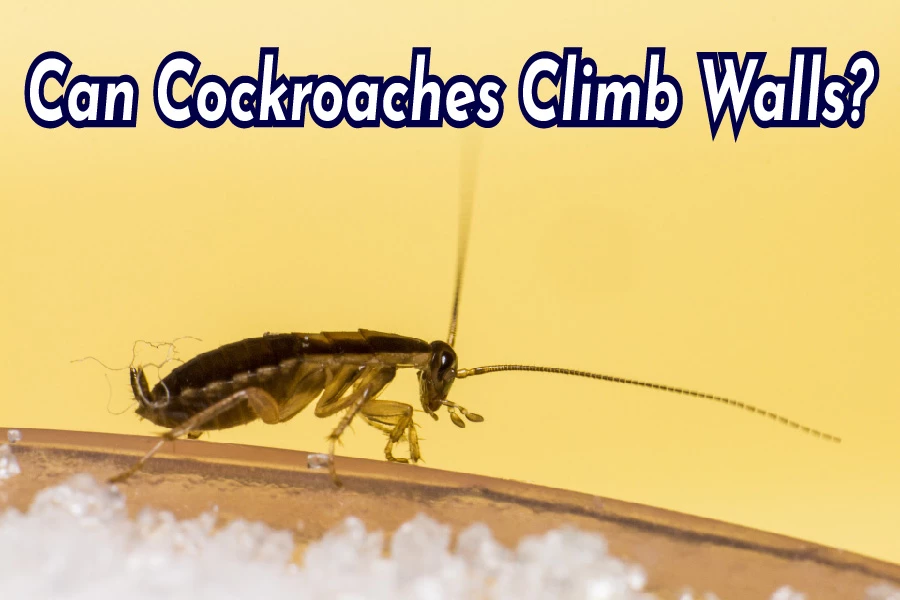Cockroaches are part of the order Blattodea, and they are wingless insects that have evolved to adapt to different environments.
They are also one of the most despised creatures globally, and for a good reason. These little critters are disease carriers that scurry around our residences.
There are more than 4,500 species of cockroaches, and they live on every continent except Antarctica.
So, can cockroaches climb walls? If you wanted to know whether this was true, here’s an article to give you what you need to know about the roaches climbing ability.
Can Cockroaches Climb Walls?
Yes. Cockroaches are known to climb walls and traverse ceilings, exploring areas where they aren’t wanted. They enter a home or residence through tiny cracks around windows, doors, and plumbing.
They have a pair of hooked claws with which they cling to surfaces and scale them. The legs also have tiny hairs, which help the roach detect air currents and make it easier to move around.
How Do Cockroaches Climb Walls?
Generally, cockroaches can climb swiftly on surfaces such as;
- Wood
- Drywall
- Brick wall
- Stone
If you have ever wondered how a cockroach can climb on walls, there are some answers to that question:
Hairs On Limbs
Cockroaches have thousands of microscopic hairs on their legs. Their feet are covered with tiny hairs, known as setae, Latin for bristle. It helps them feel the slightest change in the surface they are climbing.
The foot of the cockroach has two pads of many small hairs surrounded by a sticky cuticle substance, which distribute pressure across the surface of their feet. These hairs aid in gripping and climbing.
The pads on the cockroach’s feet also signal touch and chemical changes in the environment.
Claws
Cockroaches have barbs and claws to help them climb walls. The claws are attached to the tips of their legs and can cling to rocks, wood, glass, and even plastic.
The barbs and claws on the roaches’ legs allow them to grab and dig into whatever surface they move or climb on.
Cockroaches can use their claws to hang on when they are upside down, which most insects cannot do.
The barbs cover the top of their feet in small hairs. These hairs have tiny hooks which help the cockroach hold on to a surface.
The cockroach moves its left leg onto the wall and then pivots its body around to get its right leg up. When it reaches the top, it uses both legs to crawl horizontally.
Special Antennas
Roaches have special antennas called cerci, which they use to detect movement and vibrations.
Roaches use their cerci to feel their way around. They also use them to detect changes in air pressure.
If you’ve ever had a roach crawl up your wall or ceiling, it was probably sensing the air pressure change as it moved closer to an opening in the corner of the ceiling or wall nearby.
Can Cockroaches Climb Smooth Surfaces?
Researchers have found that cockroaches can climb much more slippery surfaces than previously thought.
While they are not Spider-Man, they can stick to walls and hang upside down. This is their secret to survival.
Cockroaches can climb smooth surfaces like glass and reach up to 12 inches. They have special pads that provide them with traction on slippery surfaces. This helps them maintain their grip on vertical surfaces even when they’re upside down.
Cockroaches can climb up smooth vertical surfaces, such as tiles, glass, or other shiny surfaces using their tarsal claws.
The American cockroach can climb up a glass that inclines up to 45 degrees without sliding and hold on to a glass surface underwater.
Interestingly, cockroaches can fall from any height and still be unharmed. They can withstand forces that kill other insects when falling from great heights.
Surfaces that might be too slippery/smooth for them are;
- Porcelain
- Granite
- Smooth metal
- Marble
Are All Cockroaches Climbers?
There are many species of climbing cockroaches; the Madagascar hissing cockroach, for example.
This species is a fast climber and can even climb vertical glass surfaces upside-down. However, the oriental cockroach is not a climber.
The Oriental Cockroach
This particular cockroach is not a climber; it does not possess the physical characteristics necessary to climb. Their legs are too short, their tarsi (feet) are too small, and the pads on their feet are too weak.
Therefore, it means that an oriental cockroach will not scale any vertical surface, no matter how high or smooth the surface is.
The oriental cockroach is a widespread species of cockroach around the world. In the United States alone, there are less than 100 species of cockroaches found in homes, and the oriental cockroach is one of the most common. They are also incredibly resistant to pesticides.
The oriental cockroach is about ½ to 5/8 inches long and reddish-brown. Like other cockroaches, it has wings, but it no longer uses them for flying. Instead, it uses them to create “swimming” movements to move on land quickly.
How Fast Can A Cockroach Run?
The American cockroach can run up to 3 miles per hour.
A roach has two wings but only uses them for short flights from perch to perch. It hurries along much like an insect version of Sonic the hedgehog on the ground, with a speed of up to 5 feet per second (3.4 miles per hour). Quite interesting.
Can Cockroaches Jump?
Cockroaches are not built for jumping, so their jumps are not very far or high, but they can move pretty fast for an insect. However, the leaproach is the only species that can jump.
The Saltoblattella montistabularis, commonly known as the leaping cockroach(leaproach), is native to South Africa.
It is a saltatorial insect, and it moves by jumping. With its powerful legs, it can jump between 8 and 10 cm high and exceed its height by 50 times, making it the most athletic member of its family.
The leaproach looks very much like a grasshopper. Its bright brown color with yellow stripes helps it blend in with surrounding vegetation as it jumps.
When it lands, it holds its front legs out to the side and sways back and forth as if they are broken.
The leaping cockroach has a slender body with long legs, each ending in three tarsal segments (a type of foot).
It is dark brown with yellow stripes running down its sides and long antennae with bead-like structures at their tips.
Where Do Cockroaches Live?
You’ll find cockroaches in almost every country around the world. They are considered to be one of the most common insects. Some scientists believe that up to 4,500 different species of cockroaches exist worldwide.
- Cockroaches can live just about anywhere on planet Earth except Antarctica.
Some prefer warm and warmer climates, while others prefer cold climates or a temperate environment. Cockroaches can live almost anywhere on the planet because they are very adaptable creatures.
- They have a hard outer shell called an exoskeleton that protects them from their enemies and helps them survive when food is scarce.
- In addition, to withstand extreme temperatures, cockroaches can also hold their breath for up to 40 minutes!
- Cockroaches are also not picky eaters. Their diet includes almost anything they can find, including dead insects, rotting plant matter, and even paper. They’ll even eat each other dead or alive!
You’ll find roaches in the gutters and sewers and dark places. They can be found in many homes, restaurants, movie theaters, and other places where food is prepared or served.
Inside your home, you’ll find them in the ceilings, cracks, under cardboard boxes, under furniture, in the attic, bathrooms, and kitchens.
Normally, cockroach females lay their eggs in a small dark area, such as under a refrigerator or stove or inside furniture.
What Are The Health Risks Associated With Roaches?
Roaches are a well-known health hazard in the United States. These tiny creatures can creep into even the smallest nooks and crannies, multiplying and spreading germs that lead to illness.
Cockroaches are notorious for being pests and carriers of diseases. Not only do they spread disease and pathogens, but they can also make you sick through their droppings and saliva and cause serious diseases such as dysentery and Typhoid fever.
Not all roaches pose the same threat; the American cockroach carries the most human pathogens, while the Asian cockroach carries fewer. Cockroaches have also been associated with allergies.
Conclusion
Roaches can climb walls and ceilings. They have a pair of hooked claws with which they cling to surfaces and scale them. With all of the facts presented in this article, we hope you’ve learned some interesting things about cockroaches.
In addition to climbing walls, these pests can survive without food or water for long periods—yikes! Their bodies are durable enough to withstand most types of insecticides, so it’s important to take precautions when you notice an infestation.
Please get in touch with your local pest control service today for help getting rid of these pests!
 Being Human
Being Human




